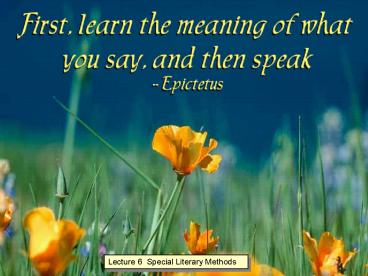Lecture 6 Special Literary Methods - PowerPoint PPT Presentation
1 / 22
Title: Lecture 6 Special Literary Methods
1
Lecture 6 Special Literary Methods
2
Literary contextual analysis is about the
interpreter examiningthe entire line of thought
of the writer.
3
Guidelines for contextual study
- What is the general outline of the book?
- How does the passage fit with the author's
argument? - How does it relate to the passages preceding and
following it?
4
3) What was the authors perspective?
- Noumenologically means something is seen from
God's perspective. - Phenomenologically means something is seen from
the authors or humanities perspective.
5
4) Does the passage state descriptive or
prescriptive truth?
- A descriptive passage relates what was said or
happened at a particular time. - Prescriptive passages claim to be articulating
normative principles (particularly the epistles).
6
5) What constitutes the teaching focus of the
passage and what represents incidental details
only?
- 6) Who is being addressed in the passage?
7
From the specific to the general
- Consider the pericopes before and after the
passage? - 2) Consider the entire book.
- 3) Consider other books by the same author.
- 4) Consider the Testament.
- 5) Consider the overall biblical perspective.
8
As Luther admonished us, "Scripture interprets
Scripture.
9
Parallel material means identical or similar
language or ideas found in a different context
from the one being studied.
- 1) verbal cross-referencing - Wording in two
passages is similar.
10
2) Conceptual cross-reference - A verse/passage
in one book has the identical substance of
another even though the same words are not used.
- 3) Parallel cross-references exist when two or
more books of the Bible describe essentially the
same events.
11
When we ignore context, we leave ourselves open
to proof-texting, which can lead us into error.
12
1 John 226-27 I am writing these things to
you about those who are trying to lead you
astray. As for you, the anointing you received
from him remains in you, and you do not need
anyone to teach you. But as his anointing teaches
you about all things and as that anointing is
real, not counterfeit just as it has taught
you, remain in him. (NIV)
13
Contextual AnalysisUnderstand how the passage
fits into its immediate context.
- Preface (11-4)
- Apostolic message its moral implications
(15-22) - 1st Application of the tests (23-27)
- 2nd Application of the tests (228-46)
- 3rd Application of the texts (47-55)
- 3 Witnesses and our consequent assurance
(56-17) - 3 Affirmations and concluding exhortation
(518-21) Stott, The Letters of John, Grand
Rapids Eerdmans, 1992, 61.
14
Contextual AnalysisUnderstand how the passage
fits into its immediate context.
- 1st Application of the tests (23-27)
- Obedience, or the moral test (23-6)
- Love, or the social test (27-11)
- A digression about the church (212-14)
- A digression about the world (215-17)
- Belief, or the doctrinal test (218-27)
- Stott,The Letters of John, Grand Rapids
Eerdmans, 1992, 61.
15
Literary Analysis - Allegories, Types, Prophecy,
Apocalyptic Literature
16
An allegory is an extended metaphor, an
unexpressed comparison. Its narrative is
manifestly fictitious.
- Guidelines for interpreting allegory
- 1. Use historical-cultural, contextual,
lexical-syntactical, and theological analyses. - 2. Determine the points of comparison intended by
the author by studying the context and the points
he emphasized.
17
Examples of Allegory in the Scripture
- Psalm 808-19 Israel as a Vine
- John 101-16- Jesus as a Gate, Shepherd, Devil
as the thief, wolf - Eph. 611-17 Armor of God
18
A type is a preordained representative
relationship which certain persons, events, and
institutions bear to corresponding persons,
events, and institutions occurring at a later
time in salvation history.
19
The prefigurement is called the type and the
fulfillment is called the antitype.
- Types resemble in one or more ways the things
they prefigure. - A type always precedes historically its antitype.
20
Typology rests on an objective understanding of
the historical narrative.
- There must be a notable point of resemblance
between type and antitype - There must be evidence that the type was
appointed by God to represent the thing typified.
- A type must prefigure something in the future.
21
Principles for Interpreting Types
- 1)The real point of resemblance between type and
antitype should be defined. - 2) The points of difference and of contrast
between type and antitype should be noted. - 3) The OT types are capable of complete
interpretation only by the light of the gospel.
22
Examples of Type in the Scripture
- Suffering Servant (Is. 53) Christ
- Noahs Family Baptized believers (1 Peter
318-22) - 1st Adam 2nd Adam Rom. 512-21

